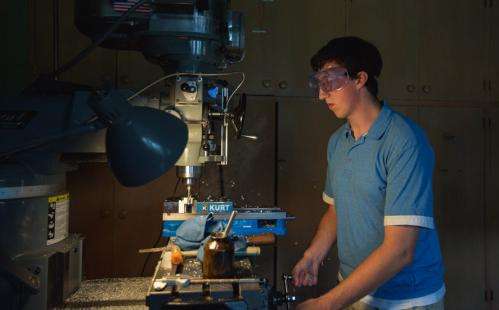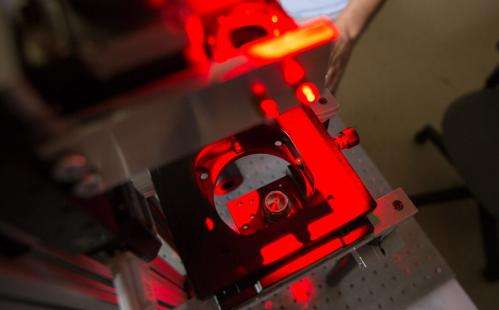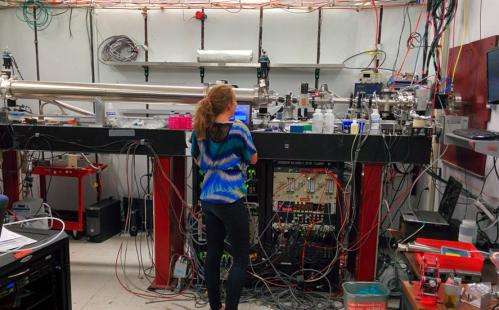Students use physics to unpack DNA, one molecule at a time

If two individuals have the same genetic predisposition for breast cancer, why does one person develop cancer while the other does not?
Is it possible to use physics to help ensure that these genetic predispositions never manifest themselves?
Biophysicist and physics professor Kurt Andresen thinks so. He and his students have spent the summer researching how our DNA packs together, how this packing may expose certain disease-causing (or curing) DNA regions, and how we might be able to manipulate these molecules and their packing to prevent harmful genetic traits.
Funded by Gettysburg's 2012 grant from the Howard Hughes Medical Institute, their work is exposing Andresen's students to graduate-level research in physics, and is helping to inform the larger scientific community's research on DNA packaging and disease.
In Fall 2013, Andresen spent the semester researching in Dutch physicist Dr. John van Noort's laboratory at the Leiden Institute of Physics, where he was trained in building and using magnetic tweezers to measure DNA packing. By attaching microscopic magnets to the ends of a single DNA molecule, scientists use the tweezers to manipulate and measure the molecule's packing—determining the directions and distances in which they can stretch the molecule, and what forces are required to do so.
When Andresen returned in Spring 2014, he recruited physics major Steve Kenyon '15 to help him recreate this device back on campus. Following instructions from Dr. van Noort's lab, he and Kenyon used Gettysburg's on-campus machine shop to build and customize parts.
Back in the lab, Andresen and Kenyon pieced together these specifically-tailored parts to build their own set of magnetic tweezers.
This device uses a homemade inverted microscope—essentially, a microscope flipped upside down—to conduct a precise measurement of the magnet's distance from the microscope (and thus, the DNA molecule's length) as they manipulate the magnetic force pulling the molecule.

"Unlike most techniques, which study lots of molecules at once, with these magnetic tweezers we are looking at one DNA molecule at a time," explains Andresen. "These so-called 'single-molecule' techniques are at the cutting edge of biophysics research, allowing us to understand how a single DNA molecule might behave in our bodies."
As they use the tweezers, the process is observed and measured on a computer program developed at the Leiden Institute of Physics, which Kenyon has programmed and customized to Andresen's lab's unique equipment. In the picture below, the circles on the screen show the magnets connected to the DNA molecules, and the lines surrounding the circles allow Kenyon and Andresen to determine the length of the molecules over the course of the experiment.
"I was interested in this project mainly because it combines several different disciplines," said Kenyon. "There's the programming element, the engineering element, and the physics behind the whole thing that makes it possible. The theory behind the tweezers also combines several disciplines; biology, classical mechanics, thermodynamics, statistics, and optics all come into play. The idea of using all of these disciplines together to arrive at a solution to a problem made this an enticing project."
Another of Andresen's researchers, physics major Abby Bull '16, helped conduct complementary measurements earlier this summer when she joined him at Cornell University's Cornell High Energy Synchrotron Source (CHESS). At CHESS, Bull used extremely bright x-rays to study the spacing between small bundles of DNA and proteins (known as nucleosomes), and to determine the physics that drives the packing of DNA in our bodies.
"It was motivating to work at CHESS alongside graduate students," said Bull. "Seeing them excited about their research—whether they were amidst running their experiments or giving their final theses defenses—made me want to follow in their footsteps and continue research in a graduate program."
Back in Andresen's lab, Bull built upon her work at CHESS by measuring the ionic charge surrounding the DNA molecules in their various packed states. To conduct these measurements, she and Andresen prepare samples that suspend charged DNA molecules in solutions containing other particles of varying charge; this variation allows them to experiment with specific charge conditions that exist in the human body.
These samples are mechanically extracted and fed through small tubes into Gettysburg's Inductively Coupled Plasma Atomic Emission Spectroscopy (ICP-AES) machine, which injects tiny quantities of the mixture into a chamber that heats them to temperatures comparable to the surface of the sun.

Once heated, the differently charged molecules surrounding the DNA molecule give off light, the color of which helps Bull and Andresen determine the types and amount of charge surrounding the DNA in its packed state.
These measurements are fed into a software program that measures the various charges of these packed nucleosomes—which, compared alongside their packed state, helps the team determine how positive and negative charges are manipulating the packing of DNA molecules.
This is important, says Andresen, because the physics of how and why our DNA molecules are packed can help explain why two individuals with the same genetic dispositions may or may not develop the same health problems. And if we can learn to understand this DNA packing, we can create drugs that manipulate our DNA packing to reduce our exposure to these harmful genetic traits.
"We can't change our DNA," he said. "That was determined a long time ago by the mixture of DNA we got from our parents. But someday we may be able to change which parts of our DNA are turned on or off, which is almost as good!"
Andresen, Bull, and Kenyon plan to continue their research this fall, and the magnetic tweezers will be used again in the spring when Andresen pairs up with chemistry professor Shelli Frey to teach an HHMI-funded Cross-Disciplinary Science Institute at Gettysburg College (or X-SIG) course, "Salty and Fatty." In this advanced laboratory course, students will learn about DNA packing and biophysical research as they examine the many ways that charge (salts) and fats interact inside of the human body to execute the many processes needed to keep us alive.
Provided by Gettysburg College


















